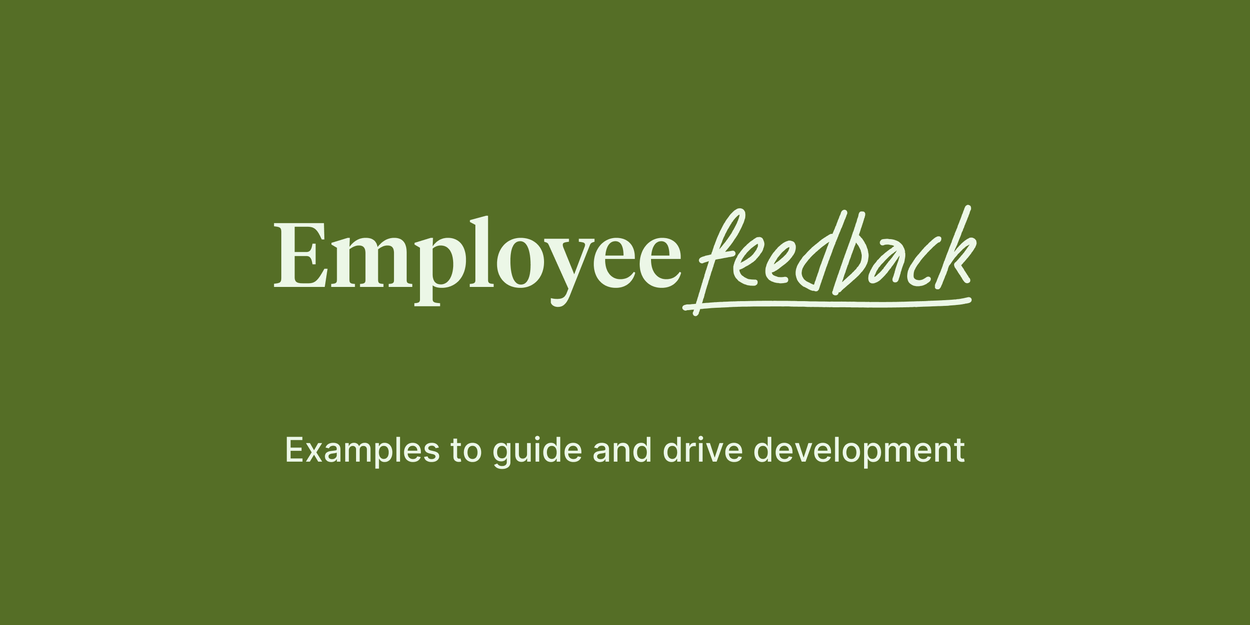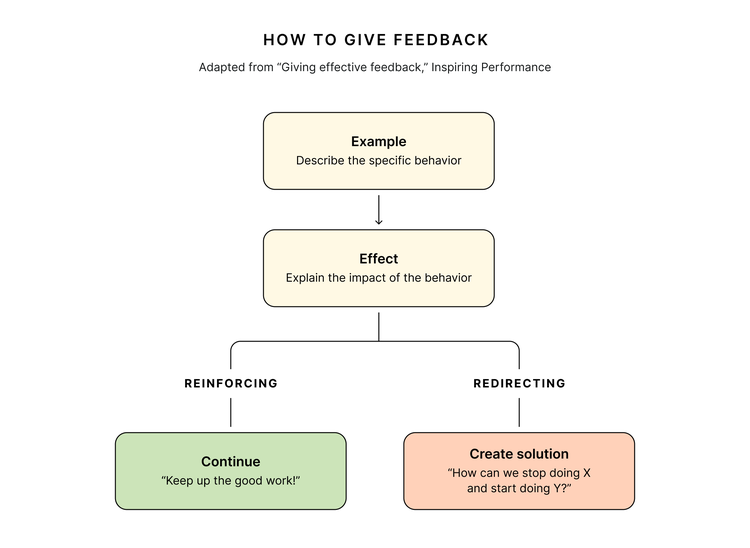
Employee feedback: Examples to guide and drive development

Written by

Writer, Culture Amp

Senior Content Marketing Manager, Culture Amp
Ongoing employee feedback is critical to moving away from outdated performance reviews and towards driving employee development. Employee feedback is any information given about a person’s actions or accomplishments at work, which is then used to guide future improvement.
However, when we think about receiving feedback at work, the first thing that comes to mind is often not-so-happy memories of our last performance review. The typical annual performance review process doesn’t inspire self-confidence or a feeling of excitement, nor does it really drive employee development or growth.
Don't you think it's time we changed that?
A culture of feedback is only possible when we learn to give feedback in impromptu moments, not just during the formal performance review process. In this blog, we'll share examples of employee feedback that you can use to guide yourself and your team toward a culture of continuous feedback.
Whether you're a manager or a fellow team member, giving feedback to others doesn’t need to be intimidating. Below, we provide examples of the different types of employee feedback, how to ask for and learn from feedback, and things to keep in mind when giving feedback.
Types of employee feedback
Commonly, people think of two types of employee feedback: "positive" and "negative" feedback. Positive feedback is usually associated with praise or congratulatory feedback, whereas negative feedback is generally associated with criticism.
However, there's a different way to frame this spectrum of feedback: reinforcing and redirecting feedback.
- Reinforcing feedback is given when we want someone to keep doing a certain positive behavior (e.g., being proactive about taking on new challenges). When we give this type of feedback, we verbally reinforce the positive effects of someone’s actions.
- Redirecting feedback is given when we want someone to stop doing X and start doing Y (e.g., speaking up more at meetings). This type of feedback is intended to correct, inspire, and motivate better behaviors. Compare redirecting feedback to negative feedback, which only tells someone to stop doing something.
Reinforcing feedback and redirecting feedback both qualify as forms of constructive feedback. This kind of feedback is future-oriented and grounded in the belief that an employee can make tangible improvements as both an individual and a team member.

What's the right balance to strike?
We recommend giving more reinforcing feedback than redirecting feedback.
You might be familiar with the old adage of the “feedback sandwich," in which you "sandwich" negative feedback between two pieces of positive pieces feedback. While this "sandwich" format isn’t strictly necessary to give effective feedback, we agree that focusing more on the positive can be helpful. That’s one of the reasons why participants in our employee effectiveness surveys can choose up to five strengths but only up to three areas of improvement.

Now that we’ve explored the two types of feedback and how to balance them, let’s look at some feedback examples.
Examples of reinforcing employee feedback
Reinforcing feedback can be given at any time. The more often you provide reinforcing feedback to your direct reports or peers, the better.
Josh Sloan, a People Scientist & Data Lab Lead at Culture Amp, explains:
“Feedback doesn’t have to be when you’re sitting down for a 1-on-1 meeting. It’s valuable to get feedback (especially when it’s positive) at any time. It’s like when you get a present on a day that’s not your birthday – it’s extra special because it’s unexpected.”
Use these examples as a framework, adjusting the language to what feels natural.
1. “Something I really appreciate about you is...."
Example: “Something I really appreciate about you is your aptitude for problem-solving."
2. “I think you did a great job when you…[insert specifics]. It showed that you had…."
Example: “I think you did a great job when you ran the all-hands meeting. It showed that you are capable of getting people to work together and communicate effectively. I admire your communication skills."
3. “I would love to see you do more of X as it relates to Y”
Example: "One of your most impactful moments was how you handled Project X. You showed the power of user testing in shaping a feature roadmap. Your efforts increased the likelihood that we satisfy and delight our users. I'd love to see you do more of this.”
4. “I really think you have a superpower around X”
Example: “I really think you have a superpower around making new hires feel welcome."
5. “One of the things I admire about you is…”
Example: "One of the things I admire about you is your ability to manage a team remotely."
6. “I can see you’re having a positive impact in…”
Example: “I can see you’re positively impacting your new office. People seem happy to have you on their team.”
Examples of redirecting employee feedback
Redirecting feedback is often more difficult to give than reinforcing feedback. However, it's vital – and even desired – that you provide it. According to a study documented by the Harvard Business Review, 92% of respondents agreed that “redirecting feedback, if delivered appropriately, is effective at improving performance.”
While reinforcing feedback can also be given at any time, it's good practice to ask before providing someone with redirecting feedback. Ensuring the recipient is in the right mindset to receive whatever you say is essential. Before giving feedback, try to get a feel for how the person is feeling and whether or not that person is aware of the topic on which you want to give feedback.
After ensuring that the recipient is prepared, you can use the following examples to frame your feedback:
1. “I’d like to give you some feedback. Is now a good time?”
This is a great way to open and kick off the conversation. It signifies to someone that you are about to provide feedback and that you are thinking about how they’re feeling.
2. “Do you have a moment to catch up about how X went?”
This is a good segue to use after a project or presentation. The person’s response will often clue you in on their thoughts. Then, you can expand on the areas of improvement you noticed.
3. “Can we debrief on X?”
This phrase is especially useful in a project-based environment but can be utilized anytime to start a feedback conversation. Be sure to give the person time to share their own feelings on the situation.
4. “Can we talk about X? what do you think is going well or what didn’t go well?”
This phrase is handy when checking how your direct report (or peer) thinks things are going. It sets the stage for a feedback conversation they can lead rather than leaving them surprised by the feedback.
5. “This is difficult for me to say...”
This is most appropriate for intense, extreme, or challenging situations. It can be a good way to prompt or notify someone that you will provide significant feedback. Acknowledging that you’re nervous shows that you want to start a productive conversation, not cast blame or make them feel bad.

Your step-by-step guide to a performance process that boosts engagement, retention, and motivation
Giving third-party feedback
If you're a manager, you'll sometimes receive feedback about your direct report from others.
Giving third-party feedback is tricky because feedback should generally avoid hearsay and focus on an individual’s unique experience. Nonetheless, you should be prepared to discuss third-party feedback, as it can come up.
At Culture Amp, we recommend using the phrase below to start the conversation.
"Can I share with you a bit of feedback that I/we have been hearing?"
Six tips for giving effective employee feedback
The examples above are intended to help you give effective feedback to fellow team members or direct reports. It’s important to note that there are many factors that go into giving someone feedback besides the language you use to start the conversation.
With that in mind, here are six tips for giving effective feedback.
1. Be conscious of timing
Put yourself in the shoes of the person about to be given feedback. Consider whether they are in the best mindset to receive your feedback and if you have the right mindset to give it. Strong emotions can cloud a person’s ability to accept feedback, whether it's positive or negative, reinforcing or redirecting. Wait for a more neutral time to provide feedback.
2. Be prepared
Think about the person you're about to speak with before giving feedback. Consider the following:
- What is the purpose of your feedback, and what do you want the outcome to be?
- Do you see value in the person changing or repeating their behavior?
- How do you think they could do so to achieve this outcome?
Your feedback needs to give enough information for someone to either continue what they've been doing or change it. However, it's hard to properly deliver this information without prior thought and preparation.
3. Provide specific examples
Specificity is essential for learning, whether you give reinforcing or redirecting feedback. Without specificity, people may be confused about what specifically they should continue or stop doing. Telling someone they did a good job or are a great team player is a nice compliment, but that person won't know which behaviors they should repeat in the future.
4. Make feedback actionable (and future-focused when possible)
Research shows that we aren't motivated to change when we receive criticism for past behavior. We simply shut down and become defensive. In contrast, feedback that addresses what we can do to reach our goals or improve ourselves is empowering and motivating.
That's why it's essential to give employee feedback on behaviors someone can do something about. Avoid targeted, personal feedback such as “you are lazy." Not only is it non-specific, but it's also (an often unfair) judgment of who that person is rather than what they're doing. People grow, but altering core personality attributes is extremely difficult. Instead of calling them "lazy," it would be better to provide feedback such as:
- I think it would be helpful if you would proofread your work before sending it to clients.
- Over the next quarter, I'd love to see you take more initiative in leading projects and helping your team members.
- I've noticed that you often submit your work a few days past the original deadline, which impacts other teams. How can we mitigate this in the future?
5. Make employee feedback a regular process
Not every action or situation will require feedback, but it's important to make regular feedback a priority. When reinforcing feedback is given often, redirecting feedback becomes less of an ordeal. Regular feedback also shows people that you care about them personally.
6. Be mindful of cultural differences
If you work in a global company, it's important to consider cultural differences in giving and receiving feedback. For example, while straightforward language is often preferred in countries like the United States, other countries may prefer more indirect forms of communication.
How should I ask for feedback?
In an organization with a strong and healthy feedback culture, people don't just give or receive feedback – they ask for it.
That's why one way to diffuse tension around giving and receiving feedback is to ask for it more often. The more feedback is incorporated into your routine, the less stress builds up around feedback conversations. While we might be biased towards feedback at Culture Amp (one of our values is learning faster through feedback), we honestly believe that feedback is the best way for people to grow and develop. That's why we strongly recommend adopting upward feedback – giving feedback to your manager and others above you.
Start soliciting feedback from your team by using the following questions:
- Is there something I can do to improve?
- Can you tell me how you felt about that?
- What did you like about my project/presentation?
- How do you think I can get better at _____?
- Do you have any advice for me on improving _____?
Five steps for learning from employee feedback
Feedback is a two-way street. We can receive it, but it doesn't mean much if we don't apply it. Moreover, when we show others that we can incorporate feedback to drive our development, others may try harder to embrace feedback themselves.
Of course, learning from feedback is often easier said than done, particularly when we're receiving redirecting feedback. If you resonate with this, try this five-step process for learning from feedback.
1. Just listen
Approach feedback with one goal in mind: listening. Listening to feedback is the first step to learning from it.
Chloe Hamman, a Lead People Scientist at Culture Amp, elaborates:
“Critical or redirecting feedback can put us in a defensive mode and restrict our ability to focus on solutions – we want to react. Knowing this, we can see why it is important to develop the habit of first just listening to feedback, rather than reacting.”
2. Remain receptive and open
Everyone has room to learn and grow, but we can only do so if we know about those opportunities. When making sense of feedback, focus less on whether you did or did not do something specific. Instead, ask yourself, "What about my behavior that could lead to this perception?"
For example, you might be given feedback such as “You need to be more assertive.” Though this isn't the best example of effective feedback, you would ask yourself, "What could be influencing people to perceive me this way?" By staying open-minded, you can better understand why you're receiving the feedback and if there are any actions or behaviors you may have been unconsciously demonstrating.
3. Ask follow-up questions
If you don’t fully understand someone’s feedback, ask open-ended questions to keep the conversation going.
Consider the feedback example, “You need to be more assertive.” You could ask, “Can you tell me more about what being assertive would look like?” By asking follow-up questions, you can gain more insight into the behavior and understand what you should stop, start, or continue to do in the future. It also ensures you have the clarity you need to hone in on the crux of the feedback.
For example, you may think that the feedback has to be about "speaking up more at meetings" when it's really about "amplifying your successes in front of leaders."
4. Act on feedback
Take the time to process feedback. Focus on what specifically you will do to change or reinforce a certain behavior. Then, try to apply this feedback to your day-to-day work. Taking the same assertiveness example in #3, your next step might be to speak up more in meetings.
5. Say thanks and show gratitude
Giving feedback can be a challenging and scary thing to do. Few people enjoy confrontation, and even fewer people like to hurt others' feelings. That's why it's so important to show gratitude and appreciation to the people who have provided you with feedback.
Not only will you be more likely to get honest, valuable feedback in the future, but you'll also be helping to build a culture of ongoing feedback in your company.

Create a culture of continuous feedback
From performance reviews to a culture of feedback
So, what does creating a culture of feedback mean for the future of performance reviews?
Annual performance reviews were intended to improve performance and increase return on investment. Historically speaking, they've generally accomplished neither. Providing feedback on an ongoing basis is a better way to help people grow and develop at work. Leaders, managers, and peers can deliver and receive feedback from one another (a process commonly known as 360-degree feedback). Feedback – done well – enables individuals and teams to continuously iterate and improve.
To start transitioning from annual reviews to ongoing feedback, create a regular cadence of 1-on-1 meetings within teams to set new expectations. Feedback also doesn’t have to be top-down.

